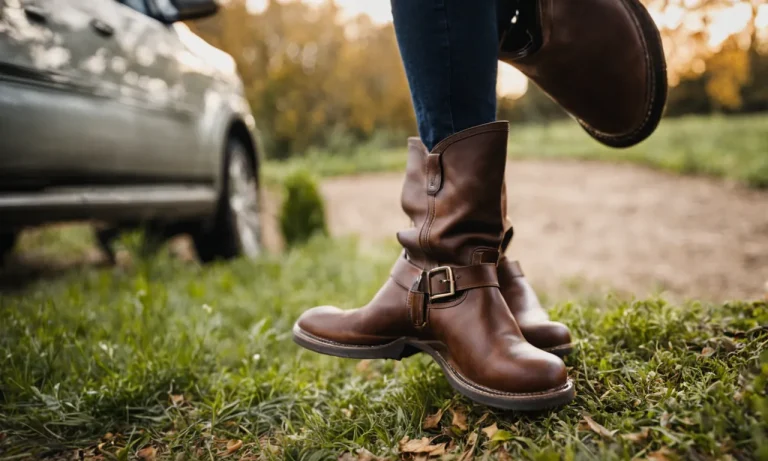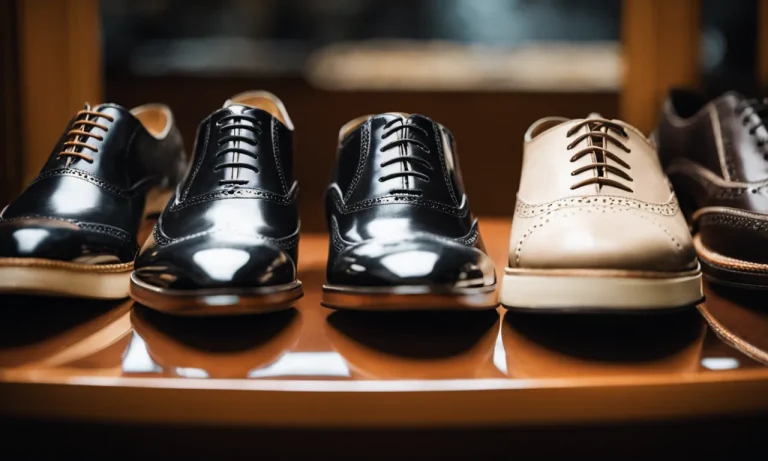If you’re looking to customize or restore old shoes, learning how to paint shoe soles is a fun DIY project. But with so many paint options out there, how do you know which type of paint is best for painting shoe soles?
In this comprehensive guide, we’ll walk you through everything you need to know to find the ideal paint for your shoe soles and achieve long-lasting results.
If you’re short on time, here’s the quick answer: For most shoe sole painting projects, acrylic paint is your best bet. It’s flexible when dry and bonds well to polyurethane and rubber soles. Be sure to use a paint formulated for plastic, apply a primer coat, and seal with a finisher spray.
Cleaning and Prepping Your Shoes
Remove Laces and Inserts
Before you start cleaning and prepping your shoes, it’s important to remove the laces and any inserts. This will make it easier to access all areas of the shoe, including the soles. Plus, it will prevent any cleaning agents from damaging or discoloring the laces.
Clean the Soles Thoroughly
To ensure the best possible adhesion of the paint to the shoe soles, it’s crucial to clean them thoroughly. Begin by removing any loose dirt or debris using a soft brush or cloth. You can also use a toothbrush to reach into the crevices and corners.
Once the dry cleaning is complete, you can move on to a more thorough cleaning.
There are several ways to clean the soles, depending on the material. For rubber or plastic soles, you can use a mixture of warm water and mild soap. Dip a sponge or cloth into the soapy water and gently scrub the soles, paying attention to any stubborn stains.
Rinse the soles with clean water and pat them dry with a towel. For leather soles, you can use a leather cleaner or saddle soap to clean and condition them.
Lightly Sand for Better Adhesion
Once the soles are clean and dry, you may want to consider lightly sanding them to improve the adhesion of the paint. Sanding the soles will create a slightly rough surface, allowing the paint to adhere better. Use a fine-grit sandpaper and gently sand the soles in a circular motion.
Be careful not to sand too aggressively, as it may damage the material.
Wipe Down With Solvent
Before applying the paint, it’s recommended to wipe down the soles with a solvent. This will remove any remaining residue or oils that could affect the paint’s adhesion. Acetone or isopropyl alcohol can be used as solvents, but be cautious when using them on certain materials, as they may cause damage.
Apply a small amount of the solvent onto a clean cloth and wipe down the soles thoroughly.
Remember, the key to a successful shoe sole paint job is proper cleaning and prepping. By following these steps, you’ll be well on your way to achieving a professional-looking finish that will last.
Choosing the Right Paint for Your Soles
When it comes to painting shoe soles, it is important to choose the right type of paint that will adhere well to the surface and withstand wear and tear. Here are four popular options to consider:
Acrylic Craft Paint
Acrylic craft paint is a versatile choice for painting shoe soles. It is widely available in various colors and finishes, making it easy to find the perfect shade for your shoes. This type of paint dries quickly and forms a durable, flexible coating on the soles.
However, it is important to note that acrylic craft paint may not be as resistant to scuffing and peeling as other options. It is best suited for occasional wear or decorative purposes.
Fabric and Multi-Surface Paint
Fabric and multi-surface paint is another great option for painting shoe soles. This type of paint is specifically designed to adhere well to different surfaces, including rubber and plastic. It provides excellent coverage and is highly durable, making it suitable for everyday wear.
Additionally, fabric and multi-surface paint often comes in a wide range of colors, allowing you to customize your shoe soles to your liking.
Rubber and Plastic Paint
If you are looking for a paint specifically formulated for rubber and plastic materials, rubber and plastic paint is the way to go. This type of paint is designed to bond effectively to these surfaces, ensuring a long-lasting finish that won’t crack or peel easily.
Rubber and plastic paint is highly resistant to abrasion and provides excellent adhesion, making it ideal for shoe soles that undergo heavy use or outdoor activities.
Custom Shoe Paint
If you want to take your shoe customization to the next level, consider using custom shoe paint. This type of paint is specially formulated for sneakers and other footwear materials, providing superior adhesion and flexibility.
Custom shoe paint often comes in a variety of vibrant colors and finishes, allowing you to create unique designs and patterns on your shoe soles. Some popular brands for custom shoe paint include Angelus and Jacquard.
When choosing paint for your shoe soles, it is important to consider the material of the soles and the level of wear and tear they will be subjected to. Don’t forget to properly prepare the soles by cleaning and sanding them before applying the paint for better adhesion.
Experiment with different techniques and products to find the best paint for your specific needs and unleash your creativity!
Priming Your Soles
Before applying any type of paint to your shoe soles, it is important to properly prime them. Priming helps create a smooth and even surface for the paint to adhere to, resulting in a more professional-looking finish. There are a few different priming options to consider:
1. Sanding
Sanding the soles of your shoes is a common method used to create a rough surface that allows the paint to adhere better. Start by using a fine-grit sandpaper to gently roughen up the soles. This will help remove any existing finishes or coatings and create a better bond with the paint.
After sanding, make sure to wipe away any dust or debris before proceeding.
2. Acetone or Rubbing Alcohol
Another way to prime your shoe soles is by using acetone or rubbing alcohol. These substances help remove any oils or residues that may prevent the paint from adhering properly. Simply apply a small amount of acetone or rubbing alcohol to a cotton ball or cloth and wipe down the soles thoroughly.
Allow them to dry completely before moving on to the next step.
3. Primer Spray
If you prefer a more convenient option, you can also use a primer spray specifically designed for shoe soles. These sprays provide a quick and easy way to prime your soles, ensuring optimal paint adhesion. Simply follow the instructions on the spray can to apply an even coat of primer to the soles.
Allow the primer to dry completely before applying the paint.
It is important to note that the priming method you choose may depend on the type of shoe material and the paint you plan to use. Always refer to the manufacturer’s instructions for the best results.
For more detailed information on priming shoe soles, you can visit websites like www.shoematters.com or www.wikihow.com.
Applying Paint in Thin, Even Layers
When it comes to painting shoe soles, applying the paint in thin, even layers is key to achieving a professional-looking finish. This not only ensures that the paint adheres properly to the sole, but also helps to prevent clumps or streaks that can make the shoes look messy.
To achieve this, start by cleaning the soles thoroughly to remove any dirt or debris. Use a mild soap and water solution, or a specialized shoe cleaner, and scrub the soles gently with a soft brush. Rinse them well and allow them to dry completely before proceeding.
Next, choose a high-quality paint that is specifically designed for shoe soles. Look for a paint that is flexible, durable, and provides good coverage. One popular option is Angelus Leather Paint, which is known for its excellent adhesion and long-lasting results.
This paint is available in a wide range of colors, allowing you to customize your shoes to your liking.
Before applying the paint, it’s a good idea to tape off any areas of the shoe that you don’t want to get paint on. This will help you achieve clean, crisp lines and prevent any accidental smudges or drips. Use painter’s tape or masking tape for this purpose.
When it comes to actually applying the paint, use a small brush or sponge applicator. Dip the brush or sponge into the paint, then gently dab or brush it onto the sole in thin, even strokes. Start with a light layer and allow it to dry completely before applying additional coats.
This will help you achieve a smooth, even finish.
Remember to be patient and allow each layer to dry fully before applying the next one. Rushing the process can result in a sloppy finish and may cause the paint to crack or peel over time. Depending on the type of paint used, it may take several coats to achieve the desired opacity and coverage.
Once you have applied all the necessary coats of paint, allow the shoes to dry completely before wearing them. This typically takes at least 24 hours, but it’s always best to check the manufacturer’s instructions for specific drying times.
Tips for a Successful Paint Job:
- Work in a well-ventilated area to avoid inhaling fumes.
- Use a paintbrush or sponge specifically designed for fine detail work.
- Apply the paint in thin, even layers to prevent clumps and streaks.
- Allow each layer to dry completely before applying the next one.
- Follow the manufacturer’s instructions for drying times and any additional steps, such as sealing the paint.
By following these tips and applying the paint in thin, even layers, you can achieve a professional-looking finish on your shoe soles. So go ahead, get creative, and give your shoes a fresh new look!
Sealing the Paint Job
Once you have completed painting your shoe soles, it is essential to seal the paint job to ensure its longevity and durability. Sealing the paint will help protect it from wear and tear, as well as the elements. Here are some effective methods to seal your painted shoe soles:
1. Clear Sealant Spray:
One of the easiest ways to seal your painted shoe soles is by using a clear sealant spray. This spray creates a protective barrier over the paint, preventing it from chipping or fading. Simply hold the can about 6-8 inches away from the shoe sole and spray evenly.
Allow the sealant to dry completely before wearing the shoes.
2. Mod Podge:
Mod Podge is a popular adhesive and sealant that can also be used to seal painted shoe soles. Apply a thin layer of Mod Podge over the painted surface using a brush. Make sure to cover the entire sole evenly. Allow it to dry for a few hours, and then apply a second coat.
This will provide an extra layer of protection and ensure a long-lasting paint job.
3. Acrylic Finisher:
An acrylic finisher is specifically designed to seal acrylic paints and can be an excellent option for sealing shoe soles. Apply the finisher with a brush or sponge, making sure to cover the entire painted area. Allow it to dry according to the manufacturer’s instructions.
Acrylic finishers come in various finishes, such as matte or glossy, so choose the one that best suits your desired look.
Remember, sealing the paint job is crucial to maintain the vibrancy and longevity of your painted shoe soles. It will protect your hard work from scratches, scuffs, and fading, allowing you to enjoy your customized footwear for a long time.
If you’d like to learn more about shoe customization or explore different painting techniques, check out www.shoe-tease.com. They offer valuable tips and tutorials on how to transform your shoes into unique and stylish creations.
Conclusion
Customizing your shoes with a fresh coat of paint on the soles is a fun, creative way to make them look brand new. With the right prep work, paint, and top coat, your painted soles can look amazing and last for many wears to come.
We covered all the key steps in this guide, but feel free to get creative with colors and designs to match your personal style!






